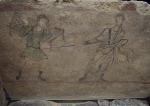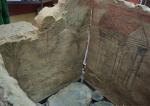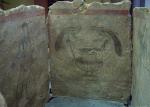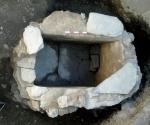Summary (English)
PHILIPPOPOLIS (Maya Martinova – maya_martinova@abv.bg) The site was situated outside the fortification wall. Part of a cardo was discovered, paved with syenite slabs. Houses of the Roman period were excavated, built of roughly-cut stones bonded with mortar; a drain built of bricks and a water-conduit of terracotta pipes were also discovered. During the 3rd century AD, the southern necropolis of the city appeared over the debris of the houses. A kiln for production of building ceramics of the 5th – 6th century AD was excavated there. The graves in the necropolis were constructed within the debris of the earlier houses. An Early Christian grave covered with tegulae was discovered. The burial pit was dug into the earlier structures. Scattered skeletal remains of seven individuals were also discovered on the site. An Early Christian tomb with frescoes of the beginning of the 4th century AD was discovered. The tomb consisted of one chamber covered with horizontal stone slabs, built of roughly-cut stones bonded with mortar, with floor paved with stone slabs bonded with mortar. The tomb was oriented east – west and measured 1 m by 2 m and 1.40 m in height. The frescoes were painted in five colors: red, white, black, ochre and green. They showed two evangelical scenes with miracles of Jesus. These were one of the earliest images of Jesus in the Christian iconography known so far. Jesus was represented as a noble Roman citizen: beardless and with short curly hair, wearing a tunic and a pallium. The Raising of Lazarus from the Dead was represented on the northern wall of the tomb. Lazarus was represented wrapped in a shroud and tied with ribbons like a mummy, standing at the entrance of a building. Healing the Paralytic was represented on the southern wall. A kantharos with two peacocks was represented on the eastern wall, symbolizing the miracle of Changing Water into Wine at Cana and the spring of life. A Christogram inside a wreath between two palms was represented on the western wall. The tomb was looted. Skeletal remains from four individuals, one of them a man, and a bone hairpin were found in the tomb. Philippopolis was among the earliest Christian centers in the Roman Empire. The first Christian community in Philippopolis was established in AD 36 – 37 by Saint Ermus who died as a martyr. The beginning of the 4th century AD, when the tomb was built, was a turning point for Christianity. In AD 313 Licinius and Constantine the Great issued the Edict of Milan, which ended the persecution and Christianity was recognized as equal to other religions in the Roman Empire.
- Maya Martinova - Archaeological Museum – Plovdiv
Director
- Maya Martinova - Archaeological Museum – Plovdiv
Team
Research Body
- Archaeological Museum – Plovdiv






![Download [PDF]](/excavation/skins/fasti/images/results/download_sml.png)







